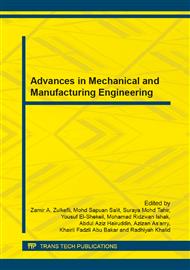p.164
p.170
p.176
p.182
p.189
p.197
p.204
p.210
p.216
Implementing Neural Network for Damage Severity Identification of Natural Kenaf Fibre Composites
Abstract:
The emergence of natural fiber as a potential alternative for glass fibre replacement has seen various development and investigation for various applications. However, the main issue with the natural fibre reinforced composites is related to its susceptibility to impact damage. This paper presents a preliminary case study of damage identification in Natural Fibre Composites (NFCs). The study involves a simple experiment of impact on a NFC panel. The strain data are measured using piezoceramic sensors and the response signal was investigated. Then an effective impact damage procedure is established using a neural network approach. The system was trained to predict the damage size based on the actual experimental data using regression method. The results demonstrated that the trained networks were capable to predict the damage size accurately. The best performance was achieved for an MLP network trained with maximum signal features, which recorded the error less than 0.50%.
Info:
Periodical:
Pages:
189-193
Citation:
Online since:
June 2014
Authors:
Price:
Сopyright:
© 2014 Trans Tech Publications Ltd. All Rights Reserved
Share:
Citation:


